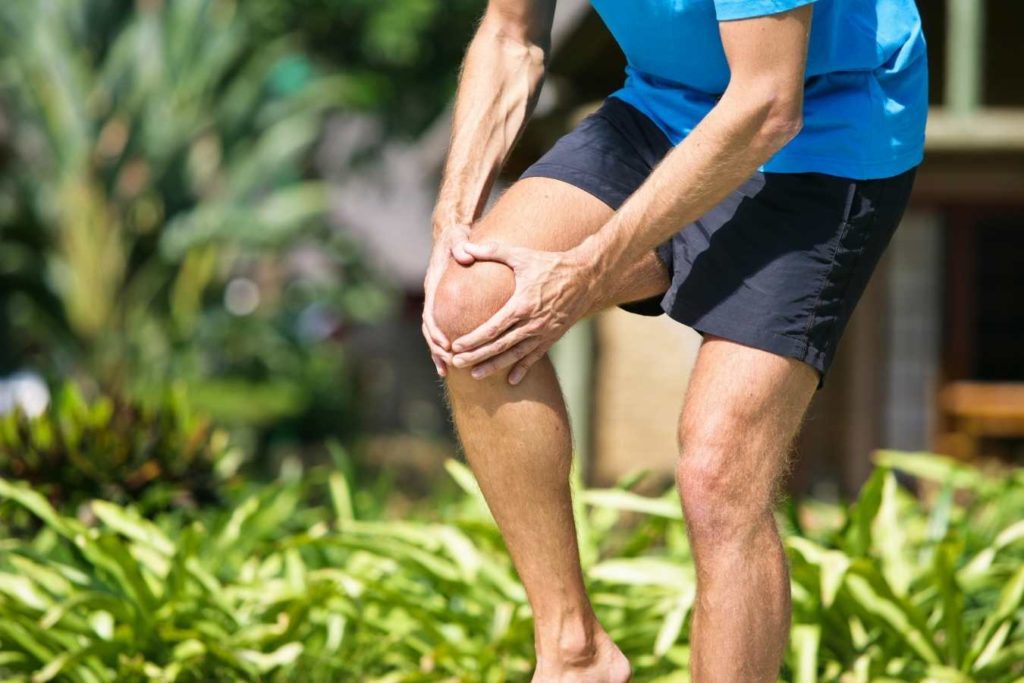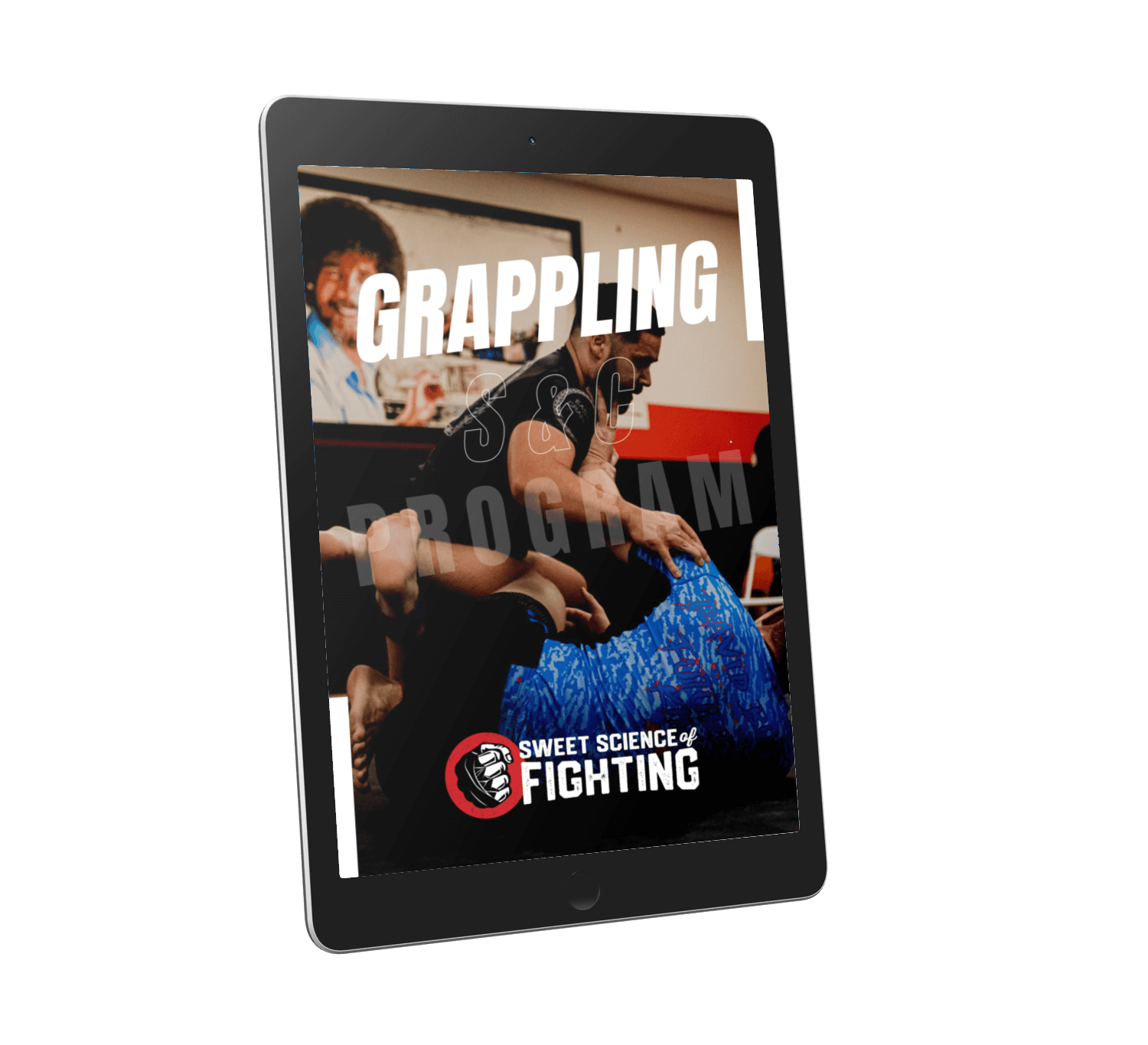Knee pain can come at you at any time when training a lot of BJJ. Whether it’s getting up and down on the mats, or the repetitive drilling of double legs, your knees can take a beating. Especially if you don’t have a strength training background.
Luckily, I have four amazing exercises that can reduce your suffering on the mats and relieve your knee pain almost instantly. They can be performed as part of your warm-up or even when throughout your day.
But first, I need to cover some knee pain that can’t be fixed through exercise.
Common BJJ Submissions Causing Knee Injury

Heel Hook
The heel hook is a nasty submission that locks your upper leg in place while twisting your lower leg. Since your hips can’t rotate, all of the torque is placed through the knee. Eventually, the ACL can’t take the stress and it snaps.
If you’re lucky, you tap early enough to sustain no injury or a slight meniscus tear which is damage to the cartilage.
Both of these injuries require surgery to repair. However, if the meniscus tear is only minor, then a quick scope is generally only needed.
Knee Bar
The knee isn’t supposed to hyperextend to the degree a knee bar places it under. This is one way you definitely don’t want to injure your knee as you’ll essentially destroy everything inside. Not to mention tear the hamstrings.
Can You Prevent These Knee Injuries?
Unfortunately, even with a well-rounded BJJ strength program, these movements apply too much pressure to the knee. It doesn’t matter how strong your legs are, the ligaments will be torn to shreds.
So instead of focusing on these major knee injuries, let’s talk basic knee pain. Specifically, patella tendon pain known as tendinosis. This is a very common knee complaint, especially among BJJ practitioners.
Kneeling on the mats all the time or thrusting forward with the knee on the mat to shoot takedowns can leave you a little tender. Especially if you have weak quadriceps.
5 Step Blueprint To Build A BJJ Strength Workout To Demolish Your Opposition
Learn how to plan your strength training to maximize transfer to the mats.
The cause of knee tendon pain is multi-factorial. It can stem from having very tight quadriceps (specifically the rectus femoris which crosses both the knee and the hip), or it can be pathological.
Tendons are made of collagen. A very stiff tendon will have these collagen fibers cross-linking creating stiffer collagen. This can be great to a certain extent for explosive activity. However, too much can cause knee tendon pain.
By performing a very slow loading exercise, we can start to “undo” these crosslinks to create a straighter line of collagen fibers effectively making the tendon less stiff. This remodeling can help reduce the knee pain you may feel in the front of your knee.
So, what exercises should you perform to gain these adaptations?
4 Best BJJ Knee Pain Exercises
A quick note before going through these knee exercises. You can perform these at any time during your day. More than once a day is even better as tendons respond magically to load.
If you are suffering from knee tendon pain and it takes a while to warm your knees up for BJJ, I would highly recommend performing the first two exercises as your warm-up before starting class. It will dramatically reduce your knee pain come class time.
Long Duration Isometric Split Squat
This is the ultimate exercise for super slow-loaded movement. An isometric is defined as creating muscular tension with no change in muscle length. Think about trying to push a wall in your house down.
But if there’s no movement in the muscle, how is this a super slow movement for the tendon if there’s no movement at all?!
Well, under isometric conditions, the tendon is slowly lengthening which is known as tendon creep. Dr. Keith Barr, a leading tendon researcher, has a great lecture on this topic if you want to geek out below.
When performing the long-duration isometric split squat, find a comfortable split position and sit as deep as possible without the back knee touching the floor. Hold the position from anywhere from 1-5 minutes.
One set is usually enough to feel instant relief in knee pain. Personally, I’ve found just 1 x 60-90 sec is more than enough. If you are a masochist, you can aim for 5 minutes straight or perform multiple sets until you reach 5 minutes.
Reverse Nordic
While isometric exercises are great for tendon remodeling, eccentric exercise also behaves the same. The movement just isn’t as slow. So why bother with eccentric movements?
This is not just about the tendon. Eccentric exercise is the best way to lengthen a muscle. Yes, better than passive stretching.
Eccentric exercises lengthen the muscle by adding new blocks to the end of muscle fibers making them longer. These are known as sarcomeres.
By doing this, you not only improve muscle length (potentially reducing knee pain as it’s not pulling on the tendon), but you also increase the contractile velocity of the muscle and produce peak force at longer muscle lengths making you less prone to injury.
The Reverse Nordic targets the lower portion of your quadriceps. You’ll feel this as you perform the exercises.
Start by sitting on your knees. I prefer sitting on my toes versus having my feet flat. Feet flat doesn’t allow you to resist as hard. Keep a straight line from your knees to your head. A common mistake is to bend at the hips which places less stress on the quadriceps.
Once you’ve lowered backward as far as you are comfortable, break at the hips before resetting in the starting position.
2-3 sets of 4-6 are more than enough due to the intensity of the exercise.
Eccentric Drop Lunge
This is a more intense eccentric exercise that should be last on your list after performing the rest. However, as your knee starts to feel better, this can be the icing on the cake to strengthen it and completely reduce knee pain during certain movements such as shooting double legs.
The reason I love this exercise so much is it is the only knee pain exercise that has impact. Meaning you have to make impact with the ground before putting on the brakes. It’s a completely different stimulus.
To perform this exercise, you’ll need to drop off a small height. I would recommend something as low as an aerobic step like in the video. You won’t need to go much higher than this from my experience.
Step off the box and make sure to land with both feet at the same time. When you land, you should land on the ball of your front foot with your heel slightly off the ground. This will place extra emphasis on your knee.
Slowly ride the exercises straight down. Not forward placing more weight on the front foot. Hips go straight down. It should take you about 3-4 seconds to get to the bottom.
Once your knee touches the floor, place your hands on your front leg to deload your legs and stand back up.
3 sets of 10 each leg is what I’ve used and found good results with.
Eccentric Lunge Push
This exercise has been magic for my athletes. I’ve had athletes in their late 30s that struggled with knee pain have it disappear using this. It’s not for the faint-hearted though.
To perform this properly, you need to create a lot of full-body tension as you push into the wall. You want to place your front foot a few inches away from the wall. Place your hands flat against the wall around nipple height.
If you place your hands too high in the beginning, it will be difficult to keep tension as you lower yourself.
Push hard with your back leg into the wall and slowly lower your hips straight down until your back knee touches the floor. It should take you around 4-5 seconds to get to the bottom.
Once you’re at the bottom, relax and reset to the starting position before performing the next rep. While this is similar to the Reverse Nordic, the Eccentric Lunge Push targets the upper portion of the quadriceps so you’ll feel it in front of the hip.
Perform 2-3 sets of 3-4 reps each side.


